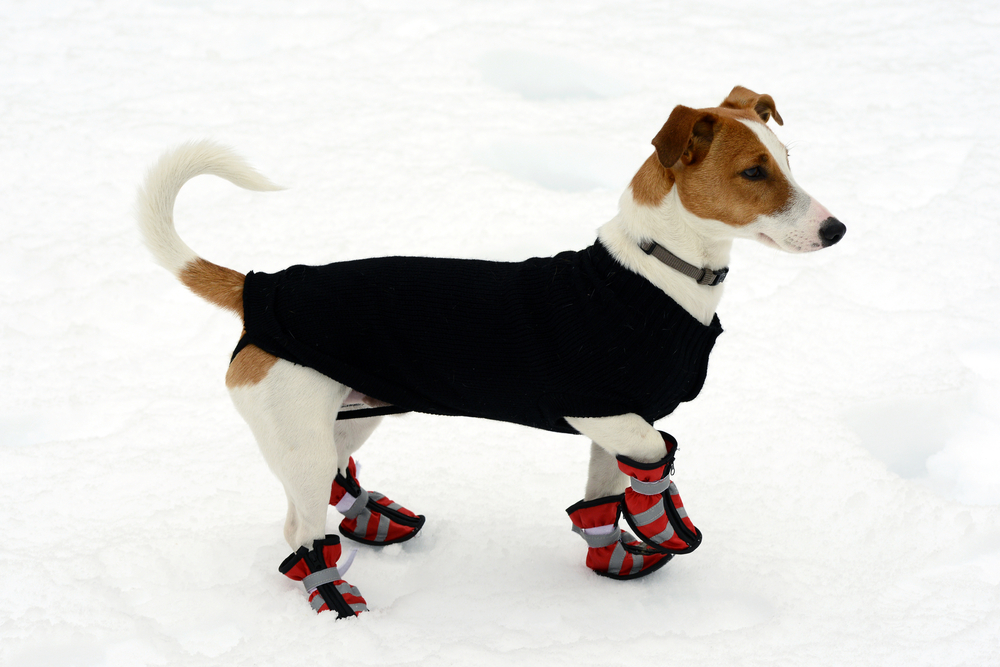Winter is settling its icy grip across the country, and with the falling temperatures comes a host of hazards that can harm your pet. Avoid the worst of the weather-related woes by watching out for the following seven cold weather dangers for pets:
#1: Beware of blazes
Nothing beats a blazing fire on a blustery day to banish cold chills. Your pet is likely to curl up in front of the fireplace to enjoy the warmth, but watch her to ensure she doesn’t get too close. Curious pets are often intrigued by dancing flames and shadow, and cats especially may be tempted to paw at the wavering light, with singed whiskers and burnt paws the casualty of their curiosity. And, after the fire has burned out, your furry friend may investigate the ashes and discover burning embers or chemicals from fire-starting logs. Always ensure your fire screen is in place and monitor your pet’s proximity to open flames.
#2: Know your pet’s limits
Although pets are wrapped in a fur coat, they are not weather-proof. Fur provides some insulation, but below-freezing or wet conditions can cause your pet’s body temperature to drop quickly. Short-haired pets succumb to chilly temperatures more rapidly than their thick-furred counterparts, as do short-legged pets, who are closer to the snow and ice on the ground. Pets with diabetes, Cushing’s disease, heart conditions, or kidney disease may have more difficulty regulating their body temperature, and become cold more quickly.
When outside, monitor your pet for these signs of hypothermia:
- Shivering
- Lethargy
- Stiff muscles
- Pale or gray gums
- Stumbling, or lack of coordination
- Fixed and dilated pupils
- Low heart and breathing rates
- Collapse
- Coma
As your pet becomes progressively colder, her body will go into heat conservation mode and become less responsive. If not treated, hypothermia can be fatal.
#3: Keep your pet off the ice
Whether there’s ice on the sidewalk or a nearby body of water, avoid a skating session. Ice-covered ponds may seem like a fun energy outlet for your exuberant pooch, but gauging the thickness and stability of the ice is difficult, and can potentially lead to a devastating breakthrough.
Whenever venturing outdoors, avoid icy areas. Older, arthritic pets, and dogs with excess fur between their toes, may slip and injure themselves on slick surfaces.
#4: Clean chemicals from your pet
During your outdoor adventures, your pet is likely to pick up chemicals on her legs, belly, and paws. Deicers, antifreeze, and other cold-weather chemicals contain toxic, potentially life-threatening, ingredients for pets. After returning home, wipe down your pet to remove salt and other chemicals to ensure she doesn’t lick them off her feet and fur. On your own sidewalk, use pet-safe deicers for the safety of your pet, and the neighborhood pets.
#5: Offer your pet bedding options
Many pet owners offer their pet the coziest seat in the house in front of the space heater, fireplace, or heating vent. Since pets have fur coats, they can become too warm and uncomfortable in this toasty spot, despite the kind gesture. Offer your pet a variety of bedding options so she can choose where to lie, based on her body temperature.
#6: Dress your pet for the weather
If your pet is short-haired or seems uncomfortable in cold weather, consider fitting her for a coat or sweater. Keep several on hand to ensure a dry one is always available, as wet clothing can make your pet colder. For pets who are trained to tolerate them, dog booties are a great way to keep your furry friend’s paws dry and protected from toxic winter chemicals. Check the fit to ensure they aren’t too tight, and that your pet is comfortable.

#7: Schedule a wintertime checkup for your pet
Car troubles, home repairs, and general health and wellness seem to take a beating during chilly months. Your pet also may suffer more during the winter, as frigid temperatures take a toll on her body. In particular, pets with osteoarthritis seem to experience more cold-weather discomfort, and they may benefit from additional therapies.
If your pet is struggling to beat the wintertime blues, or runs afoul of cold weather, give us a call for help.
